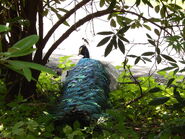
Male peacock with his tail fanned out.
Indian Peafowl is a species in a group of birds called pheasants. The males are called peacocks, while the females are called peahens. Together, they are peafowl.
Peafowl are among the largest of all birds that fly. (Ostriches, emus, and other such birds are bigger, but cannot fly.) The beautiful feathers that cover the tails of a Peacock are 5 feet (1.5 meters) long—longer than the bird's body—and can be displayed in a spectacular fan of brilliant colors. These long feathers actually grow from the bird's back not the tail. He elevates them by raising the much shorter tail feathers underneath them. A Peahen is more drab than her male counterpart, with mostly brown on their back with a white belly. Females don't have long tail feathers, but they do have a crest on their head and green neck feathers.
Indian peafowl are native to India and Sri Lanka, in South Asia. They've been introduced to other countries, usually as exhibits in parks, zoos, and nature centers or as domestic pets. The head and body of adult peafowl range from 3 to 4 feet long and their tail can be 5 feet long
Plumage[]
The Indian peacock has iridescent blue and green plumage. The peacock "tail", known as a "train", consists not of tail quill feathers, but highly elongated upper tail coverts. These feathers are marked with eyespots, best seen when a peacock fans his tail. Both sexes of all species have a crest atop the head. The Indian peahen has a mixture of dull grey, brown, and green in her plumage. The female also displays her plumage to ward off female competition or signal danger to her young.
The green peafowl differs from the Indian peafowl in that the male has green and gold plumage with black wings with a sheen of blue. Unlike the Indian peafowl, the green peahen is similar to the male, only having shorter upper tail coverts, a more coppery neck, and overall less iridescence.
The Congo peacock male does not display his covert feathers, but uses his actual tail feathers during courtship displays. These feathers are much shorter than those of the Indian and green species, and the ocelli are much less pronounced. Females of the Indian and African species are dull grey and/or brown.
Chicks of both sexes in all the species are cryptically coloured. They vary between yellow and tawny, usually with patches of darker brown or light tan and "dirty white" ivory.
Occasionally, peafowl appear with white plumage. Although albino peafowl do exist, this is quite rare and almost all white peafowl are not, in fact, albinos: they have a genetic mutation called leucism which causes an overall reduction in pigment which, in peafowl, causes a complete lack of pigment in their plumage, but still leaves them with blue eyes; by contrast, true albino peafowl have a complete lack of melanin and therefore have white plumage, but also an albino's characteristic red or pink eyes. Leucistic peachicks are born yellow and become fully white as they mature.
As with many birds, vibrant iridescent plumage colours are not primarily pigments, but structural coloration. Optical interference Bragg reflections based on regular, periodic nanostructures of the barbules (fiber-like components) of the feathers produce the peacock's colours. Slight changes to the spacing of these barbules result in different colours. Brown feathers are a mixture of red and blue: one colour is created by the periodic structure and the other is created by a Fabry–Pérot interference peak from reflections from the outer and inner boundaries. Such structural coloration causes the iridescence of the peacock's hues interference effects depend on light angle rather than actual pigments.
Female Choice[]
Multiple hypotheses attempt to explain the evolution of female choice. Some of these suggest direct benefits to females, such as protection, shelter, or nuptial gifts that sway the female's choice of mate. Another hypothesis is that females choose mates with good genes. Males with more exaggerated secondary sexual characteristics, such as bigger, brighter peacock trains, tend to have better genes in the peahen's eyes. These better genes will directly benefit her offspring, as

Female peahen in captivity.
well as her fitness and reproductive success. Runaway selection also seeks to clarify the evolution of the peacock's train. In runaway sexual selection, linked genes in males and females code for sexually dimorphic traits in males, and preference for those traits in females. The close spatial association of alleles for loci involved in the train in males, and for preference for more exuberant trains in females, on the chromosome (linkage disequilibrium) causes a positive feedback loop that exaggerates both the male traits and the female preferences. Another hypothesis is sensory bias, in which females have a preference for a trait in a non-mating context that becomes transferred to mating. Multiple causality for the evolution of female choice is also possible.










